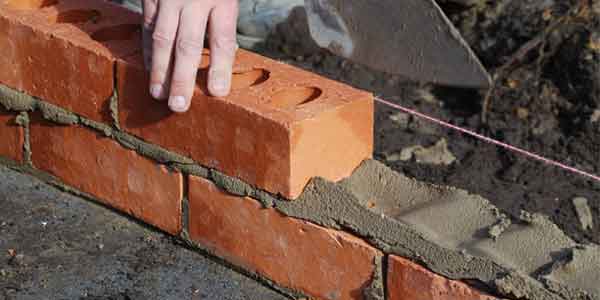There are many different types of bricks that are used in various stages of construction. These include, facing bricks, common bricks, DPC bricks and engineering bricks.
The engineering brick is quite common in construction. It has a different look and design from facing bricks, but this is because they are designed for different uses.
Engineering bricks are much like facing bricks when it comes to laying them. They have the same shape, but they do look slightly different. Generally, they have holes running through them and don’t tend to look as nice as facing bricks. However, they are laid in much the same way.
This means that mortar is applied using a trowel and the bricks are laid in place. They are usually no more difficult to lay than facing bricks.
Why Engineering Bricks are no more difficult to Lay?

Engineering bricks are very similar to facing bricks in their shape and size. This makes working with either type quite similar. Therefore, bricklayers will take a similar approach when laying this type of brick.
So, the bricklayer will lay a bed of mortar, as usual, using the same mix (occasionally you may use slightly less sand 3:1). The brick will then be placed on top of the mortar and levelled before the course of bricks is completed.
The holes might make you think that they are laid differently. But, not really, the holes simply help to improve strength. The mortar enters the holes from both sides, it then sets to create a strong bond between each course and through the bricks.
Some bricklayers find engineering bricks easier to lay, as the holes help to reduce mess. When mortar enters the holes, it means that less is lost when the brick is pressed into place.
However, issues can arise when laying engineering bricks in the rain. As more water can pass through the holes. This can result in a wet and sloppy mortar mix.
Are Engineering Bricks Hard to Point?
As mentioned previously, laying engineering bricks is much like laying any other bricks. So, when it comes to pointing engineering bricks, the process is also the same.
It is important that bricklayers achieve the right thickness of mortar between each course. Providing they do a good job of this, pointing should be just as easy, as any other brick.
Engineering bricks can be used in place of facing bricks, this is where the pointing would need to be precise. But bricklayers will use the same technique.
When laying engineering bricks, it is important to use enough mortar. You will need to think about the amount of mortar that will enter the holes in the brick. However, you will also need enough mortar to create the right bed thickness. This will then make it possible to point the engineering bricks easily.
What Are Engineering Bricks Commonly Used For?
Engineering bricks are designed to help add strength to walls and buildings. Bricklayers don’t tend to use them as facing bricks, because of their appearance. This means that they are used for their practicality and physical characteristics, rather than their looks.
These bricks are often used in civil engineering and are perfect for adding strength and resistance from frost and water.
This means, that they are commonly used underground. They are often laid as a damp proof course, because of their water-resistance and strength. However, it is also possible to use them for retaining walls, manholes, sewers, and general groundwork’s.
As most engineering bricks have holes, they can also be used to make brick pillars. A rebar or reinforcing bar can be placed through the holes. This will help to improve the tensile strength of the mortar.
Engineering bricks also come in two different classes known as Class A and Class B.
- The Class A engineering brick will have a compressive strength that is higher than 125N/mm2. They also have water absorption properties of less than 4.5%. This type of brick is suitable for specialised projects and are often used in damp coursing.
- The Class B engineering brick will have a compressive strength that is higher than 75N/mm2. They also have water absorption properties of less than 7%. This type of brick is more commonly used than Class A. They are often used in the construction of manholes.
So, engineering bricks have a range of uses but as mentioned, they are not usually used as facing bricks because of their appearance.
Conclusion
Engineering bricks are much like standard facing bricks in shape and size. But they have holes running through them, which makes them suitable for a range of different purposes.
The holes help to improve the strength of walls and buildings, and they are also quite water-resistant.
When it comes to laying engineering bricks, the process is pretty much the same. That means they are just as easy to lay as most other kinds of brick, block, or stone.




